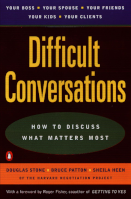 |
Full Title: | Difficult Conversations: How to Discuss What Matters Most |
|---|---|---|
| Author(s): | Douglas Stone; Bruce Patton; Sheila Heen | |
| Publishing / Edition: | Penguin Books, 2000 |
 |
Full Title: | Difficult Conversations: How to Discuss What Matters Most |
|---|---|---|
| Author(s): | Douglas Stone; Bruce Patton; Sheila Heen | |
| Publishing / Edition: | Penguin Books, 2000 |
| A Battle of Messages | A Learning Coversation | |
|---|---|---|
| The "What Happened" Conversation" Challenge: The situation is more complex than either person can see. |
Assumption: I know all I need to know to understand what happened. Goal: Persuade them I'm right. |
Assumption: Each of us is bringing different information and perceptions to the table; there are likely to be important things that each of us doesn't know. Goal: Explore each other's stories - how we understand the situation and why. |
| Assumption: I know what they intended. Goal: Let them know what they did was wrong. |
Assumption: I know what I intended, and the impact their actions had on me. I don't and can't know what's in their head. Goal: Share the impact on me, and find out what they were thinking. Also find out what impact I'm having on them. |
|
| Assumption: It's all their fault. (Or it's all my fault.) Goal: Get them to admit blame and take responsibility for making amends. |
Assumption: We have probably both contributed to this mess. Goal: Understand the contribution system - how our actions interact to produce this result. |
|
| The Feelings Conversation Challenge: The situation is emotionally charged. |
Assumption: Feelings are irrelevant and wouldn't be helpful to share. (Or, my feelings are their fault and they need to hear about them.) Goal: Avoid talking about feelings. (Or, let 'em have it!) |
Assumption: Feelings are the heart of the situation. Feelings are usually complex. I may have to dig a bit to understand my feelings. Goal: Address feelings (mine and theirs) without judgments or attributions. Acknowledge feelings before problem-solving. |
| The Identity Conversation Challenge: The situation threatens our identity. |
Assumption: I'm competent or incompetent, good or bad, lovable or unlovable. There is no in-between. Goal: Protect my all-or-nothing self-image. |
Assumption: There may be a lot at stake psychologically for both of us. Each of us is complex, neither of us is perfect. Goal: Understand the identity issues on the line for each of us. Build a more complex self-image to maintain my balance better. |